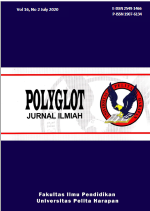KOMUNIKASI TEKNOLOGI MASYARAKAT TEPAS TANDHA YEKTI KERATON YOGYAKARTA [TECHNOLOGY AND COMMUNITY COMMUNICATION FOSTERED BY TEPAS TANDHA YEKTI IN THE YOGYAKARTA ROYAL PALACE]
DOI:
https://doi.org/10.19166/pji.v16i2.1932Keywords:
Keraton Yogyakarta, Yogyakarta Royal Palace, communication, technology, community, komunikasi, teknologi, masyarakatAbstract
The flow of technology is rapidly penetrating the walls of the Yogyakarta Royal Palace tradition as it becomes a bridge of communication, disseminating information about culture, education, and ancestral messages. In response to the changing times, the Yogyakarta Royal Palace is evolving in terms of community technology communication with the establishment of a new division of IT and documentation, Tepas Tendha Yekti, under the auspices of the sultan's daughter, GKR Hayu. This research focuses on new media in terms of technology and community communication fostered by Tepas Tendha Yekti.
BAHASA INDONESIA ABSTRACT: Arus teknologi semakin pesat menembus tembok tradisi Keraton Yogyakarta untuk menjadi jembatan komunikasi, menyebarluaskan informasi mengenai budaya, pendidikan, serta pesan leluhur. Pengalihan zaman menuntut Keraton Yogyakarta untuk berevolusi dalam segi komunikasi teknologi masyarakat dengan hadirnya divisi baru, divisi IT dan dokumentasi Tepas Tendha Yekti, di bawah naungan seorang anak perempuan sultan, GKR Hayu. Penelitian ini memfokuskan media baru dalam segi komunikasi teknologi dan masyarakat yang dibina oleh Tepas Tendha Yekti.
References
Anderson, B. R., & Crouch, H. (1972). Java in a time of revolution: Occupation and resistance 1944-1946. Pacific Affairs, 45(4), 617-618. https://doi.org/10.2307/2755692
Hildebrand, J. M. (2018). Modal media: Connecting media ecology and mobilities research. Media, Culture & Society, 40(3), 348-364. https://doi.org/10.1177/0163443717707343
Johnston, M. P. (2014). Secondary data analysis: A method that which time has come. Quantitative and Qualitative Methods in Libraries, 3(3), 619-626. Retrieved from https://www.researchgate.net/publication/294718657_Secondary_Data_Analysis_A_Method_of_Which_the_Time_has_Come/link/5903561a0f7e9bc0d58d6dd1/download
Kahin, G. M. T. (1952). Nationalism and revolution in Indonesia. Ithaca, N.Y: Cornell University Press.
Kembuan, E. M., & Irwansyah. (2019). Peran teknologi audio-visual dalam pengembangan pembelajaran anak di sekolah dasar Karya Anak Bangsa di Manado. Polyglot: Jurnal Ilmiah, 15(1), 73-92. https://doi.org/10.19166/pji.v15i1.1311
Pacey, A. (1983). The culture of technology. Oxford: Blackwell.
Selosoemardjan. (1962). Social changes in Jogjakarta. Ithaca, N.Y: Cornell University Press.
Smith, E. (2008). Using secondary data in educational and social research. New York, N.Y: Open University Press.
Suprapto, B. (1985). Perkembangan kabinet dan pemerintahan di Indonesia. Jakarta, Indonesia: PT Ghalia Indonesia.Downloads
Additional Files
Published
Issue
Section
License
Authors who publish with this journal agree to the following terms:
1) Authors retain copyright and grant the journal right of first publication with the work simultaneously licensed under a Creative Commons Attribution License (CC-BY-SA 4.0) that allows others to share the work with an acknowledgement of the work's authorship and initial publication in this journal.
2) Authors are able to enter into separate, additional contractual arrangements for the non-exclusive distribution of the journal's published version of the work (e.g., post it to an institutional repository or publish it in a book), with an acknowledgement of its initial publication in this journal.
3) Authors are permitted and encouraged to post their work online (e.g., in institutional repositories or on their website). The final published PDF should be used and bibliographic details that credit the publication in this journal should be included.





